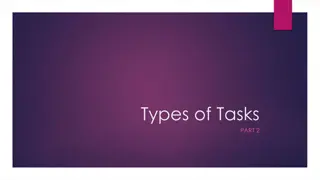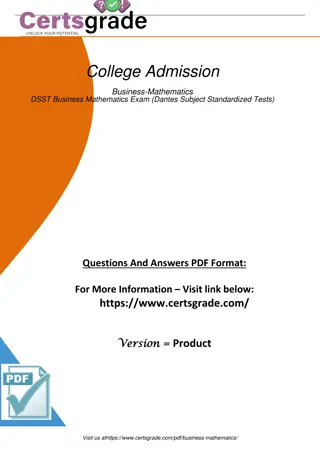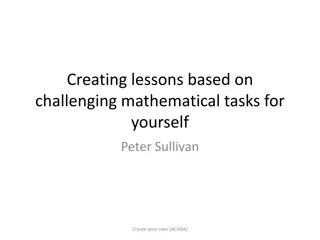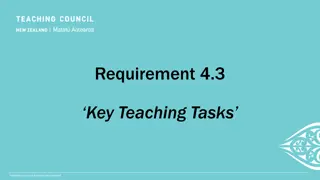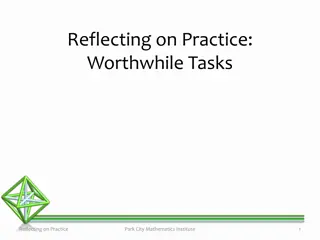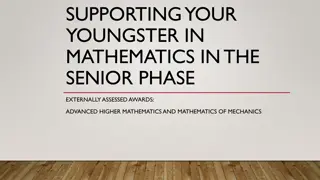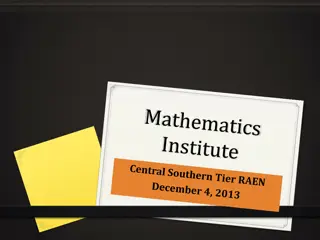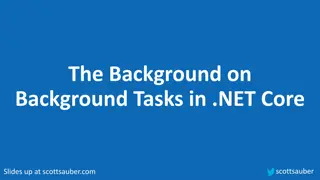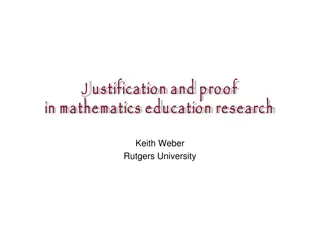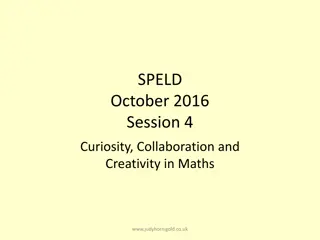Understanding Rich Tasks in Mathematics Education
Rich tasks in mathematics education are purposeful and engaging activities that encourage problem-solving, critical thinking, and collaboration among students. These tasks are designed to challenge learners at different levels, promote multiple solution strategies, and lead to meaningful learning outcomes. They integrate fluency, problem-solving, and mathematical reasoning, fostering a deep understanding of mathematical concepts. Key elements of rich tasks include accessibility, support for varying levels of challenge, and intriguing contexts to stimulate student interest. The provided content explores the concept of rich tasks in secondary mathematics programs, emphasizing their significance in enhancing students' mathematical abilities and fostering a deeper appreciation for the subject.
Download Presentation

Please find below an Image/Link to download the presentation.
The content on the website is provided AS IS for your information and personal use only. It may not be sold, licensed, or shared on other websites without obtaining consent from the author. Download presentation by click this link. If you encounter any issues during the download, it is possible that the publisher has removed the file from their server.
E N D
Presentation Transcript
Embedding Embedding MATHS 300 MATHS 300 in Secondary in Secondary Programs Programs 2018 2018 Helen Haralambous & Danijela Draskovic Mathematics Education Consultants hharalambous@mav.vic.edu.au ddraskovic@mav.vic.edu.au
What is a Rich Task? What is a Rich Task? Record 3 features of a rich task on paper provided Share with person next to you Discuss as table group Each table group share one point
What is a Rich Task? What is a Rich Task? is purposeful and engaging models how people solve real problems puts knowledge to work demonstrates what students know and can do supports multiple representations and solution strategies Offers opportunities for meaningful learning results in some product, presentation or outcome as a result of the deliberations of the group and/or individual. (DET)
What is a Rich Task? What is a Rich Task? Combine fluency, problem solving and mathematical reasoning Are accessible Promote success through supporting at different levels of challenge Encourage collaboration and discussion Use intriguing contexts or intriguing maths (adapted from NRICH)
Content strand Content strand - - Number and Algebra Number and Algebra Sub-strands Number and Place Value Real Numbers Money and Financial Matters Patterns and Algebra Linear and Non-Linear Relationships Keep the Key Concepts in mind (be aware of levels above (Yr. 9) and below Yr. 7) Year 8 Functions and Graphs Linear functions Garden Beds (From Maths 300) Crossing the River (From Maths 300)
Linear Algebra Linear Algebra Garden Beds Garden Beds Problem: A Gardener wants to protect some plants by placing a border of tiles around the edge. A gardener has 100 plants in a row in the garden bed. How many tiles will be needed to surround it (around the edge)?
Linear Algebra Linear Algebra Garden Beds Garden Beds What if there were 5 plants in a row, how many tiles will be needed? What if there were 8 plants in a row, how many tiles will be needed? A garden bed has 100 plants in a line. How many tiles will be needed to surround it? Can you find a general rule for n plants in a line?
Garden beds Garden beds Task: Using the 2 different coloured square tiles provided, or some dot paper, work in pairs to complete the Worksheet: Garden Beds: Investigation Guide Extra challenge - generalising or finding a rule Feedback: How to teach this? Start with the big question Scaffold Would you use this task? Discuss in table groups. How would you use the task? What year level?
Linear Algebra Linear Algebra Crossing the River Crossing the River Problem: A group of friends went camping on a small island in the middle of a lake. There were 8 adults and two children. When they went to cross the lake to return home, their boat was missing and only an old canoe was available. It could only carry either One adult OR One or two children They did manage to get across the lake. How did they do it and how many trips did it take?
Linear Algebra Linear Algebra Crossing the River Crossing the River Task: Using the 2 different coloured counters or 2 different coloured people figures (representing the children and adults), work in pairs to solve this problem and complete the Worksheet: Crossing the River Investigation Guide Assuming number of children is always 2, what is the number of trips required if there were 5 adults and 2 children? there were 8 adults and 2 children? Can you find a rule for n adults and 2 children?
Crossing the River Crossing the River Worksheet generalising or finding the rule Worksheet generalising or finding the rule Feedback: How to teach this? Start with the big question Scaffold Would you use this task? Discuss in table groups. How would you use the task? What year level?
Map of Australia Map of Australia Content strand: Measurement and Geometry Content strand: Measurement and Geometry TASK: Let Victoria s area be size 1 Estimate 1 complete on your own In column 1 of the table in your worksheet, write down what you think are the sizes of the other states compared to Victoria. How many Victorias will fit inside each other state/territory? Estimate 2 complete as a table group Discuss your answer with members of your table group. When you come to a consensus record this answer ( the number of Victorias that will fit inside each other state/territory) in column 2 of the table provided. Estimate 3 with the aid of a map. Look at the map provided and as a table group revise, if necessary, your solution in column 3 of the table provided.
Map of Australia Map of Australia
Map of Australia Map of Australia - - solutions solutions STATE/TERRITORY AREA of STATE/TERRITORY ACTUAL PROPORTION VIC NSW TAS QLD SA NT WA ACT 227 600 km 801 600 km 67 800 km 1 727 200 km 980 000 km 1 346 200 km 2 525 500 km 2 400 km 1 3.5 0.3 7.6 4.3 5.9 11.1 0.01
Greedy Pig Greedy Pig Content strand: Probability and Statistics Content strand: Probability and Statistics The Game: class all stand up. You are all up against each other. You are keeping a cumulative score. Teacher rolls a die Everyone writes this number on worksheet in Game 1 Teacher rolls die again Everyone adds this number to the first number in Game 1 If a 2 is rolled, the entire score becomes zero Each player can choose when they wish to keep their cumulative score by sitting Winner is the one with the highest score Play 5 games Look at class results
Greedy Pig Greedy Pig The challenge: when is the best time to sit down? Class discussion about strategies: Play again with students using the strategy they suggested. Look at class results. Who improved? Refer also to Maths300 lesson Greedy Pig
Why were these tasks RICH? Why were these tasks RICH?
One task for all One task for all Enabling prompts Start with smaller number e.g. garden beds or people crossing river. Break it into smaller, more manageable parts Extending prompts Prove to me you have all the possible solutions Can you show an algebraic modelling to solve the problem? Can you create a similar problem?
Find a task for you! Find a task for you! http://www.maths300.com/ MAV Conference participants, expires on 8 Dec 2018 Username: mavcon_temp Password: mav
Your feedback Your feedback Friday 7 December 2018 https://www.surveymonkey.com/r/MAV1807



